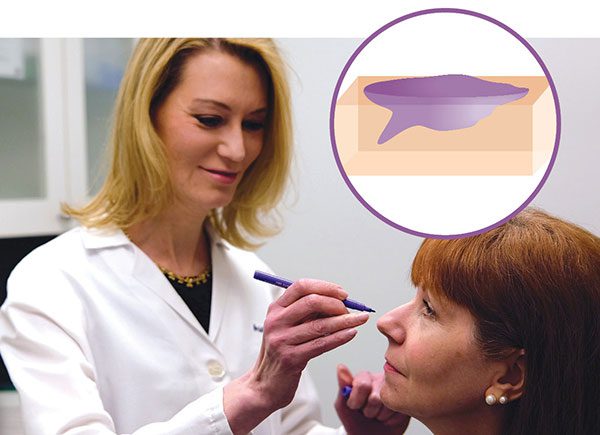Mohs Surgery – Overview
Mohs surgery, also known as Mohs micrographic surgery is a procedure used to treat skin cancers. During Mohs surgery, thin layers of cancer-containing skin are progressively removed and examined until only cancer-free tissue remains.
As a result of this technique, Mohs surgery has a high cure rate of up to 99% for skin cancer that has not been treated before and 94% for recurring cancers.
Also, Mohs keeps as much healthy skin as possible and so it’s well suited for skin cancers in areas where tissue preservation is important (face, neck, hands, lower legs, genitals).
Mohs is named after its inventor, Dr. Frederic Mohs, who first described the technique in 1941.
Reasons for Mohs Surgery
Mohs surgery is used to treat the most common skin cancers, basal cell carcinoma, and squamous cell carcinoma.
Also, Mohs surgery may be indicated for some kinds of melanoma and other more unusual skin cancers such as dermatofibrosarcoma protuberans, keratoacanthoma, spindle cell tumors, sebaceous carcinomas, microcystic adnexal carcinoma, merkel cell carcinoma, Paget’s disease of the breast, atypical fibroxanthoma, and leiomyosarcoma.
Surgical Procedure for Mohs Surgery

Mohs surgery
Mohs micrographic surgery is performed on an outpatient basis under local anesthesia and usually lasts about 4 hours but could be longer depending on the extent of cancer.
The procedure is done in stages, all in one visit, while the patient waits between each stage. After removing a layer of tissue, the surgeon examines it under a microscope in an on-site lab. If any cancer cells remain, the surgeon knows the exact area where they are and removes another layer of tissue from that precise location, while sparing as much healthy tissue as possible. The doctor repeats this process until no cancer cells remain.
Mohs Surgery Risks and Complications
As with all surgical procedures, Mohs surgery carries the risk of:
- Bleeding
- Pain or tenderness around the surgical site
- Infection
Other complications that may result from Mohs surgery are uncommon but may include:
- Temporary or permanent numbness surrounding the surgical area, if small nerve endings are cut
- Temporary or permanent weakness of the surgical area, if the tumor is large and a muscle nerve is severed
- Itching or shooting pain in the affected area
- An enlarged scar (keloid)
Mohs Surgery Cost
The total cost for Mohs surgery depends on a lot of factors such as the anesthetic fee, private hospital fee, private operating facility fee, the extent of surgery required.
Mohs surgery costs may be covered by insurance plans. Since each patient’s insurance coverage is different, it’s important to understand your plan in order to know how much, if any, of the surgery will be covered.
For example, some patients may have high deductibles where insurance will cover only a small portion of the associated costs.
On the other hand, some patients may have 80/20 plans where the insurance may cover a significant amount and the patient is only responsible for their copay.
The total cost of the procedure is around $1000 – $2000.
More: Skin Biopsy Cost


